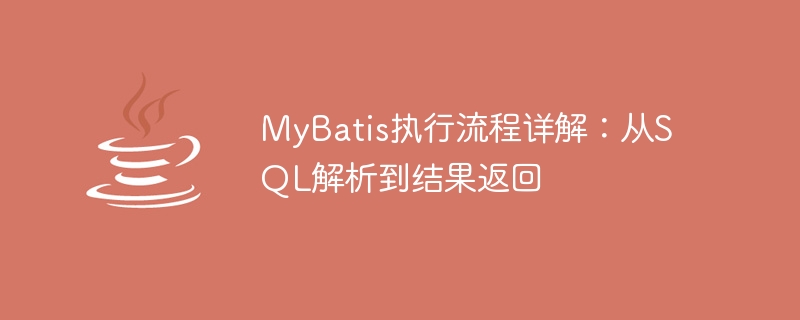

MyBatis is a popular Java persistence layer framework that is widely used in various web applications. It improves development efficiency by simplifying database operations, while also providing flexible configuration options and powerful SQL mapping functions. This article will introduce the execution process of MyBatis in detail, from SQL parsing to result return, and provide specific code examples to illustrate the implementation of each step.
Before using MyBatis to execute a SQL statement, you first need to parse the SQL statement and convert it into an executable Java object. MyBatis uses XML or annotations to define SQL statements and parameter mapping relationships, among which XML is the most commonly used. The following is a simple SQL mapping file example:
<?xml version="1.0" encoding="UTF-8" ?>
<!DOCTYPE mapper
PUBLIC "-//mybatis.org//DTD Mapper 3.0//EN"
"http://mybatis.org/dtd/mybatis-3-mapper.dtd">
<mapper namespace="com.example.UserMapper">
<select id="selectUserById" resultType="User">
select * from users where id = #{id}
</select>
</mapper>In this example, a SQL statement for querying user information is defined, and the mapping relationship of the parameter id is specified.
When a SQL statement is called, MyBatis will generate the corresponding SQL statement based on the SQL definition and parameter information, and execute the database query operation. The following is a simple Java code example:
SqlSession sqlSession = sqlSessionFactory.openSession();
try {
UserMapper userMapper = sqlSession.getMapper(UserMapper.class);
User user = userMapper.selectUserById(1);
System.out.println(user);
} finally {
sqlSession.close();
}In this example, first obtain a SqlSession instance, obtain the implementation class of the UserMapper interface through the getMapper method, and define the selectUserById method in the UserMapper interface for executing queries. operates and returns the result to the caller.
After the SQL execution is completed, MyBatis will convert the query results into Java objects and return them to the caller. The mapping type of the result is specified as User in the UserMapper interface. After the query operation is completed, MyBatis will map the query result to a User object and then return it to the caller.
Through the above code examples, we briefly introduce the execution process of MyBatis, from SQL parsing to result return. MyBatis simplifies database operations and improves development efficiency through simple configuration and flexible mapping functions. It is one of the commonly used persistence layer frameworks in Java development.
The above is the detailed content of Analyze MyBatis execution process: detailed analysis from SQL parsing to result return. For more information, please follow other related articles on the PHP Chinese website!
 mybatis first level cache and second level cache
mybatis first level cache and second level cache
 SQL statement to backup database
SQL statement to backup database
 What is the difference between ibatis and mybatis
What is the difference between ibatis and mybatis
 How to configure database connection in mybatis
How to configure database connection in mybatis
 What is the working principle and process of mybatis
What is the working principle and process of mybatis
 What are the differences between hibernate and mybatis
What are the differences between hibernate and mybatis
 Introduction to dex concept digital currency
Introduction to dex concept digital currency
 asp what file
asp what file




